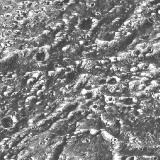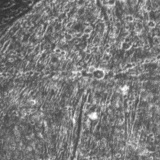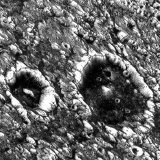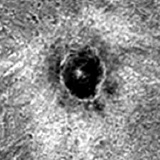 |
|||
|
Ganymede
has few craters, as the soft, flowing surface destroys them.
|
|||
| THE CRATERS OF GANYMEDE | |||
| Although not as heavily cratered as Callisto there is a wide variety of crater types on Ganymede. Both the dark terrain and the banded sulci are cratered. The banded terrain has fewer craters and is therefore interpreted as being younger than the surrounding dark materials. | |||
| As Ganymede is closer to Jupiter it ought to have had more impacts than Callisto, as the gravity of Jupiter concentrates smaller bodies closer to it. Ganymede in fact has fewer craters than Callisto. Craters on Ganymede also have a more subdued topography. | |||
 Osiris and Thoth. |
 Thoth. |
||
| The low relief and relatively low crater count is thought to be because the surface is soft and flows. The surface was warmer and flowed more rapidly, erasing the older craters and degrading more recent craters. | |||
| There are ray craters (Osiris and Eshmun for example) which resemble those found on the Moon such as Copernicus and Kepler. Like lunar craters, they are probably younger than those craters which lack a system of rays. Some craters (Kittu for example) have dark rays associated with them. The dark rays are perhaps caused by the excavation of a dark layer in the surface of Ganymede. It has also been suggested that they are made by meteorite material being incorporated into the ejecta. The dark terrain on Ganymede could have resulted from thousands of dark meteorites impacting the surface. | |||
 Ancient impact craters in the dark terrain of Galileo Regio. |
 Galileo Regio impact craters. |
||
| It appears that craters with dark rays are more common on light grooved terrain and craters with light rays are more common in the rough dark terrain. This may not be due to differences in the composition of the crust but rather because they are easier to see against a contrasting background. | |||
| Impact basins | |||
| There are no multi-ring impact basins on Ganymede. They may have existed early in the moon's history but have since been degraded beyond recognition by relaxation of the surface. It has been proposed that there are none because the crust is too thick. There are, however, a number of smaller craters with a central ring. They are considered transitional between conventional craters with a central peak and multi-ringed basins. Gilgamesh is the largest impact basin on Ganymede. It has a smooth level depression about 150 kilometres in diameter. The ejecta blanket (material thrown outward by the impact) and secondary craters extend for 500 kilometres from the centre. | |||
| Crater chains | |||
| There are several crater chains on Ganymede. Crater chains are formed by a string of asteroid or comet material, perhaps disrupted by tidal forces. The asteroid group travels in a line and when they strike they hit the surface in quick succession, like a trace of bullets. Enki Catena was formed by 13 fragments crashing into Ganymede in quick succession. | |||
 Enki Catena. |
 Crater chain. |
 Oblong craters formed by double asteroid impact. |
|
| In the Nicholson Regio part of Ganymede can be found two unusual craters, oblong in shape. The craters were formed when either a split comet, or two asteroids, impacted the surface at a shallow angle. The two asteroids could have been gravitationally bound, similar to the asteroid Toutatis. | |||
| Palimpsests | |||
| Palimpsests are bright roughly circular regions made by the excavation of material from within Ganymede by impacts. The deposits are thought to be a few hundred metres thick. The term "palimpsest" was the name given to animal skins which were used to write on. They were used repeatedly and the older writing could be seen beneath the new. Palimpsests on Ganymede are older craters with degraded topography. Though the surface has flowed like glacier ice and is cross-cut by newer features, the early craters are still faintly visible. Palimpsests, which are also found on Callisto, typically range in size from 100 to 300 kilometres across. A particularly large example, Memphis Facula, is over 350 kilometres across, but like others on Ganymede it has virtually no topography. | |||
 Memphis Facula. |
 Chrysor and Aleyn within Memphis Facula. |
 Gula and Achelous. |
|
 Nergal crater. |
 Khensu crater. |
||
|
|
|||